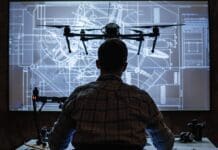This post is also available in:
 עברית (Hebrew)
עברית (Hebrew)
As part of its celebration of the People’s Liberation Army, the Military Museum of the Chinese People’s Revolution in Beijing is displaying a range of weapons including the PLA’s new self-propelled artillery, cruise missiles, ballistic missile launchers, and perhaps most notably tactical UAS.
According to the popsci.com report, there’s official confirmation that the CH-901 “kamikaze” loitering attack munitions (a short-ranged mini-drone) is in use by the PLA. The CH-901 is a 9 kilogram, fixed-wing drone with a flight speed range of 15 to 150 kph. It’s got a 2 kilometer-range electro optical camera for reconnaissance, the device also has the ability to crash into enemy targets, detonating its warhead.
At the Military Museum, a 4X4 armored fighting vehicle (AFV) is armed with a pop-up hatch that carries eight CH-901 launch tubes. The launcher also has four launch tubes for a smaller fixed-wing reconnaissance UAV.
Another 4X4 AFV had an even more interesting cargo: three large hexacopter drones, with collapsible rotor-housing struts. Carried on a slide-out rack deployed out of the rear infantry exfiltration door of the vehicle, each hexacopter is about 1.2 meter tall, with a wingspan of about 2 meters and a large dome camera mounted on the main body. The hexacopter, like the fixed wing UAV in front of it, are both used for tactical information gathering by Chinese troops.
Next to the hexacopter display was another tactical UAS of interesting design. The system is 2 meter wide, flying with its electric propellers facing down, suggesting that it could be a tilt rotor drone with vertical take off and conventional flight capabilities.
The display fits well within the wider vision of the PLA. The planned integration of unmanned systems into the tactical level—in addition to cutting the total number of ground troops to increase resources per capita—suggests the army is hoping to delegate responsibility and initiatives to lower-level officers, in light of the increasingly chaotic battlefields seen in Iraq and Ukraine.

























